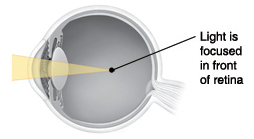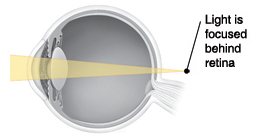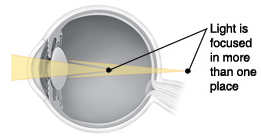A
B
C
D
E
F
G
H
I
J
K
L
M
N
O
P
Q
R
S
T
U
V
W
X
Y
Z
Click a letter to see a list of conditions beginning with that letter.
Click 'Topic Index' to return to the index for the current topic.
Click 'Library Index' to return to the listing of all topics.
Understanding Vision Problems
Normal
 |
| Normal |
Your eyes see an object as light coming from the object. Your cornea focuses light rays onto a layer that lines the inside of the back of your eye (the retina). If your eyes are normal, this creates a focused image on your retina. This makes objects look clear.
Nearsighted (Myopia)
 |
| Nearsighted |
Your cornea and your retina are too far apart if you’re nearsighted. In other words, your eyeball is longer than average. Sometimes your cornea or your lens has an abnormal shape. This makes light rays from distant objects focus in front of your retina. These objects then look blurry.
Farsighted (Hyperopia)
 |
| Farsighted |
Your cornea and your retina are too close together if you’re farsighted. In other words, your eyeball is shorter than average. Sometimes your cornea or your lens has an abnormal shape. This makes light rays from close objects focus behind your retina. These objects then look blurry.
Astigmatism
 |
| Astigmatism |
Sometimes your cornea or the lens inside your eye is curved abnormally. Then light rays can’t focus evenly onto your retina. This is called astigmatism. It makes both close and distant objects look blurry.
Online Medical Reviewer:
Daphne Pierce-Smith RN MSN
Online Medical Reviewer:
Mahammad Juber MD
Online Medical Reviewer:
Raymond Turley Jr PA-C
Date Last Reviewed:
3/1/2025
© 2000-2025 The StayWell Company, LLC. Todos los derechos reservados. Esta información no pretende sustituir la atención médica profesional. Sólo su médico puede diagnosticar y tratar un problema de salud.